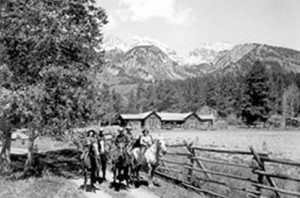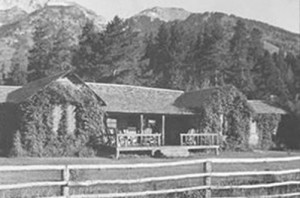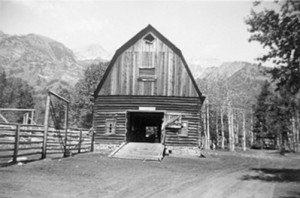In 2014, a preservation carpenter at White Grass said, “I can only imagine why Harold Hammond and Tucker Bispham picked out this property and placed the main buildings where they did, because I would do exactly as they did,” i.e., to look west, the Teton Range is in view with the the Idaho border beyond that. To the east, the Gros Ventre Mountains are visible with DuBois, WY on the other side. Yellowstone and the Absaroka Mountains are to the north. To the south, Jackson and surrounding mountains are visible. Stated simply, for most who have come to White Grass, the area is beautiful, inspiring and captivating. Most come back, many come back often, if only in their memories.
Operating a cattle/dude ranch for over 70 years (1913-1985) required owners, supervisors, support staff, a herd of horses and other animals, an infrastructure and a financial base. Converting the dude ranch to a training facility for teaching historic preservation skills (2002-2016), required assembling a team of preservation specialists and volunteers to rehabilitate log structures, many of which were built in the 1920s. Once modern water and septic systems were installed; crumbling foundations and rotten logs were replaced, kitchens rebuilt, sleeping cabins readied, and a training curriculum was created. To accomplish this, the Western Center for Historic Preservation was created in 2004 and run by the National Park Service. Training workshops at White Grass began in 2014.
The Landscape
Water off the Mountain
Ranches need a steady and predictable supply of water. Water for White Grass (1913-1985) came from snowmelt off the mountains to the west and a year round spring just west of the Main Cabin. Ditches were dug to direct water directly to the buildings, irrigation ditches in the meadow and Lake Ingeborg. Later a system of pipes from the spring served selected buildings.
Making the Ranch Go
In 1924, Harold Hammond began an operation to raise silver foxes for their pelts as a way to supplement ranch income from cattle and early dudes. The fox farm closed in the early 1940s.
As ranch operations expanded, staff were added to do a wide array of tasks. including wrangling, cooking, cleaning, office work and ranch maintenance. According to Frank Galey, in the 1930s, it was common practice at dude ranches throughout the valley to hire Chinese, Japanese and Filipino laborers. White Grass hired Filipinos as cooks. Decades later, Galey often hired college students who had come to the ranch as children for many summers with their parents. These students were hired as wait staff, cabin girls, fishing guides, wranglers and chore boys.
White Grass as a Training Facility for the National Park Service Post-2004
Owner Frank Galey sold the White Grass Ranch and its facilities to the Grand Teton National Park in 1956. Galey retained a lifetime lease allowing him to operate it as a dude ranch until his death which occurred in 1985.
In 2004 the National Park Service began work to rehabilitate the ranch as a training facility to teach preservation skills to government employees, those in the private sector, students and volunteers. Conference facilities were created in the Main Cabin and the Hammond Cabin while other log structures were to be used as sleeping quarters. The bathhouse was converted to a workshop to facilitate hands-on training experiences for workshop attendees.
Rehabilitation of each log structure was extensive with crumbling foundations replaced with poured concrete; rotten logs removed and new logs inserted; roofs reinforced and/or reconstructed; windows restored or reproduced as needed; and bathrooms totally rebuilt. The workforce included National Park Service employees, private contractors, volunteers and students interested in historic preservation.




